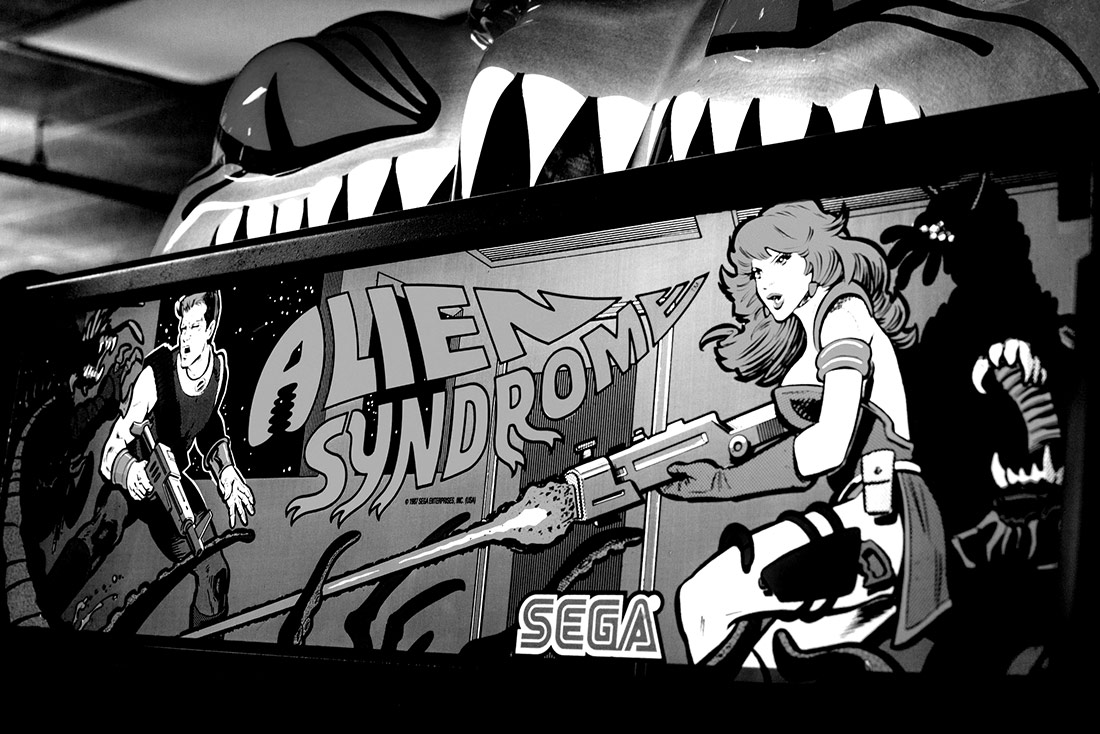
Alien Syndrome (1987 Sega) at Yestercades. Soverville, 2015 | Rob DiCaterino | CC BY
Beyond its association with the world of childhood, playing games forms part of us. It allows us to ask ourselves questions and imagine other realities, whether physically or virtually. This capacity to construct new worlds is shared with science fiction. Therefore, the mutual inspirations and transfers that have arisen between this genre and the world of video games are not mere coincidence.
When did we start playing? And imagining and asking ourselves questions? According to the explanation in Johan Huizinga’s book, Homo Ludens, playing is older than culture, it is a natural event that stems from our latent animal instinct; let’s remember that animals play too. Therefore, it is something that forms part of us. However, at some point in history, someone decided to associate the idea of playing with something that only children do, something that involves self-escape and non-thought. In the same way, there was a moment in time when someone decided that certain types of literature could only be read as a way of escaping reality, that science fiction and fantasy were only related with the imagination, and that this made them lesser literature. But imagining, asking ourselves questions, and playing, are all elements that shape us as human beings and give us a place in the world.
In fact, Miguel Sicart, in his book Play Matters, defines the act of playing as a way of understanding what surrounds us. When he thinks about the action of playing, Sicart defines it in all its depth and from all its possible characteristics. For him, the action of playing seeks to subvert the usual order, takes over the context where it takes place and is something creative, because it gives shape to its own objects and communities. “Playing gives us the world and, through playing, we make it our own”.
Playing can be whatever we want, something childish or something that encompasses all the stages of our lives; a physical space or a virtual one; a word that is simply related to toys, or a word that leads us to all its other possibilities, from imagining that we are someone else to considering that solving a mystery can also be part of a game, as Sherlock Holmes often reminds us with his “the game is on” (or “the game is afoot”, depending on the version).
Playing can also be the result of a question or it can trigger another. ”Shall we play a game?”, says Joshua to Mathew Broderick’s character in the film WarGames (John Badham, 1983). It is the answer to this question that allows the plot to develop, and the emergence of the tension, the doubt, and the outcome with a conclusion that goes beyond the initial question. A lot of stories are created in this way, starting with a question that prompts us to imagine a person’s response, or a society’s response to the possible scenario that we have put forward. Often this question takes the classic form “What would happen if…?”; one of those creative triggers that Gianni Rodari proposed as a game for children in his The Grammar of Fantasy and that takes on a completely different meaning if you change the tense of the verb, turning it into a pathological attitude that stops us from getting ahead in life because we are always asking ourselves about what might have been. But, as Ursula K. Le Guin explained, it is the question “what would happen if I open this window?”, “what would happen if people were able to change reality with their dreams?” that makes it possible for us to construct worlds. Those questions are triggers, seeds that expand until they become universes that allow us to ask and to wonder, and to understand that there are other ways of doing things, other ways of being, of thinking; other realities.

Bubble Bobble (1986 Taito), Maximum Force (1997 Atari Games), Bosconian (1981 Namco) and Space Invaders (1978 Taito) at Yestercades. Soverville, 2015 | Rob DiCaterino | CC BY
The game of creating a world
If there is one recurrent game in the world of science fiction, it is that of trying to find a definition. Authors give one, scholars offer another; in some cases, they have points in common, in others they are personal visions that come from their own creative experiences as authors, but also as readers. For example, Umberto Eco considers science fiction to be a narrative of conjecture; a type of literature that “builds structurally possible worlds”, i.e., worlds that, although they do not correspond with the experience we have at present, could become reality.
This idea connects with Philip K. Dick’s idea about science fiction, although in his case he laid emphasis on the importance of the shock of not recognising what the reader had to experience when faced with that world, that society derived from our own but that has been transformed and disfigured by the author. For K. Dick, science fiction should be stimulating for the reader, it should provoke thoughts and questions with or without answers, an idea that was also shared by writers such as Isaac Asimov and Ursula K. Le Guin. The former defended the view that science fiction was a way of searching for human answers to changes, to technological advances. For Le Guin, non-mimetic literature was a way of opening doors, of exploring questions for which there were still no answers. Ray Bradbury said that “science fiction is not an escape at all. It is a movement that dodges reality in order to enchant it and force it to behave itself. […] All science fiction is an attempt to solve problems by pretending to look the other way”. But why then, has it been seen, or why is it still being seen as a way of getting away from problems with real life, when deep down it does just the opposite? Perhaps because of ignorance? Or because of prejudices that have not been re-examined? Who knows?
The truth is that science fiction offers us, amongst other things, a view towards possible futures, towards other realities, close or distant, terrifying or stimulating. Its premises and the worlds that it has created have filtered into our collective imagination and, of course, into the world of video games. But these, too, have filtered into some creations, or at least, into certain aspects that we usually associate with the world of computers, games, and virtual reality.
In fact, before the latter even existed, Stanley G. Weinbaum wrote Pygmalion’s Spectacles (1935), a story in which a man invents some goggles that allow an illusion to be seen as if it were real, to feel it, to smell it, to touch it. It plays with suggestion and self-hypnosis, but the idea is still there, and it is tempting. However, the reality that Ray Bradbury presented in 1950 with his short story “The Veldt” is not so tempting. In the story, an interactive game room causes worry to the parents and obsession among the children. An obsession or addiction that many people have associated with video games, as they are seen as spaces where young people lock themselves away to escape from their problems and reality, to the point where they can no longer tell reality and fiction apart.
Technology, and especially technology that offers us the possibility to create a world beyond reality (be it through virtual reality or video games), has inspired many works of fiction, from Simulacron-3, by Daniel Francis Galouye, the novel that inspired the film The Thirteenth Floor, by Josef Rusnak, through to the strange and bodily eXistenZ, by David Cronenberg, up to the more recent Ready Player One, by Ernest Cline. But one must also keep in mind that the angst of not knowing whether what is being seen is real or not is a common theme in science fiction, because the fracturing of identity, the self and the other, and questioning the limits of reality, are all tropes that have run through the genre from different perspectives.
The journey in the opposite direction also has several examples. If we think of science fiction as a possibility of visiting outer space, some of the first video games, such as Space Invaders, offered us that journey in a very simple format. However, with time, video games have become the perfect space for developing scenes and narratives that are inspired by the subgenres of science fiction, from cyberpunk to interstellar journeys, through to dystopias, euchronias, and genre hybrids. With an architectural and visual constructing of worlds, that serves as a setting and a narrative framework, the video game offers the possibility of exploring other characteristics of these universes and expanding its references, because it allows players to immerse themselves in a different way. In a video game we are watching, like in the movies, but the dynamics and the language are different. One can ask oneself different questions or have to respond to others; one can participate, breathe the story and create it in a certain way as one advances; even play with the construction of the story. If we return to the idea that Sicart upholds, video games are fundamentally a way of appropriating the world; a fictional world, with narrative but also creative elements, where one can play with one’s choice and observe that reality from its interior. Whether it be physically or virtually, individually or collectively, playing games is transformative and it confronts us with dilemmas and difficulties. Playing games opens doors and possibilities. It is true that it is done within an enclosed space and with rules, but does the same not happen in everyday life? No matter how free we believe ourselves to be, we are all marked by our environment, by our families, by cultural norms, and we move by following the rules of the game.
Prejudices often stop people seeing the diversity in the world of video games and the depth that can inhabit science fiction. In the article “On the Shoulders of Giants” taken from his book Zen and the Art of Writing, Ray Bradbury imagines a boy who asks himself the reason why we didn’t start paying attention to science fiction until recently. It is a question written years ago, but one that still resonates today. In this essay he explains how some adults, thanks to children and young people, are discovering that science fiction books tell us something, that they are full of ideas…. Perhaps it is also those same children and young people who remind us today that video games already form part of our cultural universe, be it real or fictional.





Leave a comment